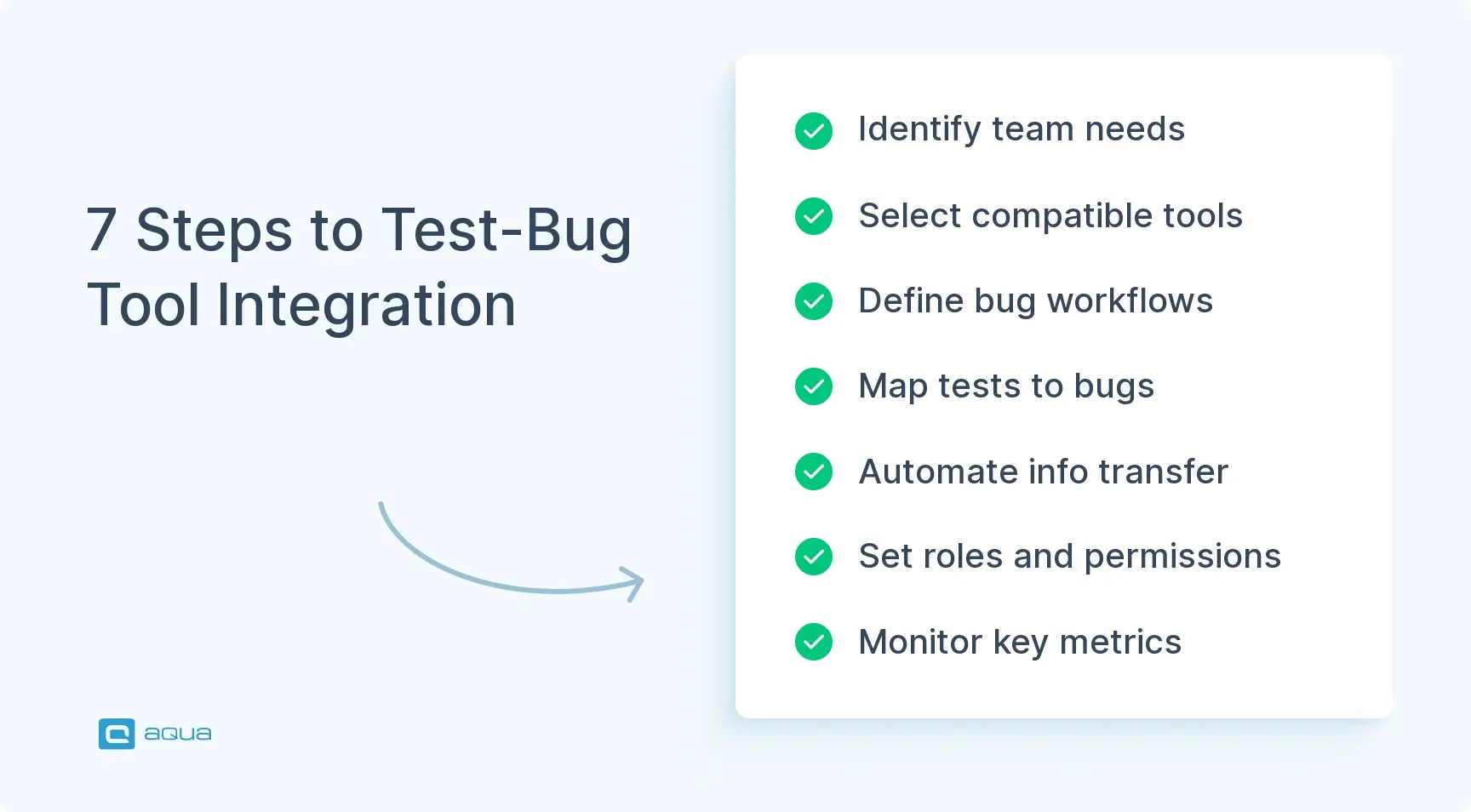Key takeaways
- QA teams can waste up to 20% of their time manually transferring information between disconnected test management and bug tracking systems.
- Effective integration requires mapping test cases to bug reports, creating strong connections that maintain context and traceability for developers.
- The integration process involves seven key steps including identifying project requirements, selecting compatible tools, and defining clear bug tracking workflows.
- Automation of repetitive tasks like bug creation from test failures and status synchronization reduces errors and improves consistency.
- Well-defined roles and permissions are essential for maintaining security and workflow integrity across both integrated systems.
Disconnected testing tools force teams to manually copy data between systems, but proper integration can eliminate this tedious work while providing better traceability between tests and bugs. See how to implement this in your own workflow 👇
Understanding Test Management Tools and Bug Tracking Systems
You need to know what each tool does before you can connect them effectively.
Test management tools handle the planning and organization of your testing work. They give you a central place to store test cases, track execution, and report on progress. You maintain a library of reusable test cases, schedule test runs, track what’s been executed, and document results.
Bug tracking systems focus on documenting and managing defects through their entire lifecycle. When testers find issues, these systems capture the details: reproduction steps, expected versus actual results, screenshots, and environment info. They route bugs to the right people and track them until resolution.
Each tool serves a different purpose, but they work best together. Test management organizes the testing process. Bug tracking manages issue resolution. Connected, they create a feedback loop that improves software quality continuously, and brings crystal-clear traceability.
Here’s a comparison of the key features of each system:
| Feature | Test Management Tools | Bug Tracking Systems |
|---|---|---|
| Primary Purpose | Plan and organize testing activities | Track and manage defects |
| Key Functions | Test case management, test execution tracking, test coverage analysis | Defect logging, assignment, status tracking |
| Typical Users | QA managers, test leads, testers | Developers, QA testers, product managers |
| Reporting Focus | Test coverage, pass/fail metrics | Defect density, resolution time |
| Integration Points | CI/CD pipelines, bug trackers | Test management, development tools |
When these systems stay separate, problems multiply. Testers discover a bug during test execution and then manually create a ticket in the bug tracker, copying all relevant details between systems. This takes time and introduces errors. Information gets lost. Duplicate bugs get created. Tracing which test found which bug becomes nearly impossible.
Let’s look at the full process of combining them effectively, so you don’t need to deal with all these issues.
How to Integrate Test Management Software with Bug Reporting Software
Integration takes planning. Here’s how to approach it step by step.
1. Identifying Project Requirements
Know what your team actually needs before you configure anything. This step gets skipped too often, and teams end up with integrations that create new problems instead of solving existing ones.
Look at how your team works today. How do you execute tests and report bugs right now? What information moves between systems? Which fields and workflows need to stay intact? Understanding this shapes an integration that supports your work instead of disrupting it.
Think beyond immediate needs. Fix today’s problems, but build room for growth. Planning to scale test automation? Make sure your integration handles higher volumes of test results and bug reports without breaking.
Get input from different teams. Developers, testers, product managers, and DevOps engineers use these systems differently. They each see different problems and opportunities. Collecting diverse perspectives helps you build something that works for everyone.
Requirements to consider:
- Bugs created automatically from failed tests
- Status updates syncing in both directions
- Attachments and screenshots transferring with bug reports
- Bugs assigned to the right people without manual routing
- Test context preserved in bug reports
- Support for your test types, whether manual, automated, API, or UI
2. Selecting Compatible Tools
Pick tools that actually work together. Not all test management and bug tracking systems integrate the same way, and choosing incompatible tools leads to complicated workarounds or features that don’t work.
Look for tools with solid API support. RESTful APIs with good documentation make custom integrations feasible and reliable. Many modern tools also offer prebuilt integrations with popular platforms, which cuts down implementation time and complexity.
Consider how the tools are built. Cloud-based solutions typically offer better integration capabilities but come with different security considerations than on premise options. Make sure the tools fit your infrastructure strategy and compliance requirements.
Workflow customization matters. The best tools let you configure fields, statuses, and transitions to match how your team actually works. This flexibility means the integration supports your workflow instead of forcing you to change it.
Factor in the total cost beyond licensing fees. Implementation costs, training requirements, and ongoing maintenance all add up. The cheapest option becomes expensive when it needs extensive customization or slows your team down.
aqua cloud combines test management and bug tracking in a single, well-integrated platform. It also supports REST API, native integrations with Azure DevOps, Confluence, and real-time Jira sync for flexible connectivity with other tools. The platform syncs test cases and defects in real time in both directions, eliminating the manual copying that wastes up to 20% of tester time. Every defect stays connected to its original test case, giving developers full context for faster resolution. What truly sets aqua apart is its domain-trained AI Copilot with RAG grounding, which can instantly generate contextually relevant test cases and automatically link them to your bug tracking workflow. This creates a unified ecosystem where every defect maintains its connection to the original test case, providing developers with complete context for faster resolution.
Reduce bug management overhead by 35% with fully integrated test management and defect tracking
3. Defining a Bug Tracking Workflow
Your integration only works if you have a clear bug tracking workflow. Without one, bugs get lost, work gets duplicated, and nobody knows who’s responsible for what.
Map the complete lifecycle of a bug from discovery to resolution. Define statuses for each stage like New, In Progress, Ready for Testing, Verified, and Closed. Establish how bugs move between these stages. Your workflow should match how your team actually works, not some ideal process that looks good but doesn’t fit reality.
Assign ownership for each stage. Who triages new bugs? Who verifies fixes? Clear roles prevent bugs from sitting in limbo because nobody knows it’s their turn to act.
Define severity and priority classifications so your team focuses on important issues first. Severity reflects technical impact: critical, major, minor, cosmetic. Priority indicates business importance: high, medium, low. Both factors determine how fast bugs move through your workflow.
Document your workflow so everyone understands it. Visual representations like flowcharts help communicate the process clearly.
Here’s a simplified example of defining bug tracking workflows:
- Bug found during test execution
- Bug created automatically in tracking system with New status
- QA lead triages bug and assigns severity and priority
- Bug assigned to developer with In Progress status
- Developer fixes bug and changes status to Ready for Testing
- Tester verifies fix and either changes status to Verified if fixed or reopens bug with Reopened status if not fixed
- Bug closed after release with Closed status
Go for aqua cloud. Whatever you need from a TMS, you will get. Its AI features are really cool and you have 100% traceability, scalability, etc. Test case, requirements and test data generation all can be done easily using AI.
4. Mapping Test Cases to Bug Reports
Strong connections between test cases and bug reports maintain traceability and context. When a tester finds an issue during test execution, the bug report needs a clear link back to the test case that found it.
This mapping gives developers context for fixing the bug. They see what functionality was being tested, what behavior was expected, and how the bug relates to specific requirements or user stories. They’re not just looking at an isolated issue.
Most integrations use one of these approaches:
Direct linking: The bug report contains a reference ID pointing to the specific test case that found the issue.
Context transfer: Key information from the test case, like steps and expected results copied automatically into the bug report.
Bidirectional references: The test case and bug report both reference each other, so you can navigate in either direction.
Make the mapping automatic whenever possible. When a tester marks a test as failed and creates a bug, the integration should establish this connection without manual work.
For manual testing, find integration features that let testers create bugs with one click from the test execution interface. For automated testing, make sure your integration creates bugs automatically when tests fail in CI/CD pipelines and maintains references to the failed test cases.
5. Automating Integration Processes
Once you’ve mapped test cases to bug reports, automation takes your integration from functional to efficient. Automation cuts manual work, improves consistency, and eliminates human error.
Identify repetitive tasks in your testing and bug management workflow. Common automation targets include:
Bug creation from test failures: When a test fails, generate a bug ticket automatically with all relevant details populated.
Status synchronization: When a bug’s status changes in the tracking system, update related test cases automatically. The reverse should work too.
Notification routing: Notify the right people automatically when bugs get created, assigned, or change status.
Data transfer: Move screenshots, logs, and other artifacts between systems without manual uploads.
Most modern tools offer APIs and webhooks for these automations. APIs let you interact with tools programmatically. Webhooks provide real time notifications when events occur. Together, they create a responsive, event-driven integration.
Teams with development resources can write custom integration scripts using tool APIs. These scripts handle complex business logic and workflows that prebuilt integrations might not support.
Teams without developers can use integration platforms like Zapier, Workato, or Microsoft Power Automate. These platforms offer visual, low-code interfaces for building integrations between popular tools without writing code.
6. Defining Roles and Permissions
Clear roles and proper permissions keep your integrated system secure and functional. Without them, people make unauthorized changes. Sensitive information can get exposed, or critical processes can break.
Map out the different roles in your testing and bug management process. Common roles include:
QA Manager: Oversees testing, needs access to reporting and dashboards
Test Lead: Manages test execution, creates and assigns test cases
Tester: Executes tests and reports bugs, updates test results and creates bug tickets
Developer: Fixes bugs, needs visibility into test cases related to assigned bugs
Product Manager: Prioritizes bugs, needs reporting access and ability to set priorities
For each role, define appropriate permissions in both systems. Use the principle of least privilege. Each role gets only the permissions necessary to do their job. This minimizes the risk of accidental or intentional misuse.
Restrict sensitive operations like deleting test cases, closing bugs without verification, or modifying workflow definitions. These high impact actions should be limited to appropriate roles only.
Permission models often differ between test management and bug tracking tools. You might need to create custom roles in one system to match the permission structure of the other, ensuring consistent access across both tools.
Document your role and permission structure clearly. Review it periodically, especially as your team grows or processes change. What works for a small team won’t scale when you add more members or teams.
7. Monitoring and Analyzing Results
Once your integration is running, monitoring and analytics show you whether it’s working and where to improve.
Define key performance indicators that align with your integration goals. Common metrics include:
Mean time to detect: How quickly are bugs identified after they’re introduced?
Mean time to repair: How long does it take to fix bugs once they’re reported?
Defect leakage rate: What percentage of bugs escape to production?
Test coverage: What percentage of requirements or code is covered by tests?
Automation rate: What percentage of tests are automated versus manual?
Integration reliability: What percentage of integration operations complete successfully?
Set up dashboards that visualize these metrics and make them accessible to stakeholders. Most test management solution platforms and bug tracking tools offer built in reporting you can customize to track your specific KPIs.
Review these metrics regularly to spot trends and patterns that aren’t obvious day to day. You might notice certain bug types consistently take longer to fix, pointing to process gaps or knowledge issues.
Use insights from your analysis to drive continuous improvement. When metrics trend in the wrong direction, investigate root causes and fix them. This feedback loop keeps your integration evolving with your team’s needs and capabilities.

When evaluating solutions for integrating your test management and bug tracking systems, consider how aqua cloud can transform your entire approach. Beyond simple synchronization, aqua provides the comprehensive platform described throughout this article: bidirectional integration with Jira and Azure DevOps, end-to-end traceability, and customizable workflows that adapt to your team’s processes rather than forcing you to change them. aqua’s visual bug reporting tool, Capture, gets you screenshots, videos, and system logs automatically, creating clear, actionable bug reports that accelerate resolution. The platform’s domain-trained AI Copilot takes integration to the next level by generating test cases, requirements, and data in seconds while maintaining project-specific context through RAG-powered intelligence. This means your AI suggestions are grounded in your actual documentation, not generic responses. With real-time dashboards that visualize relationships across all your systems, you’ll gain immediate insights into coverage gaps and defect trends without switching between tools.
Save 10+ hours per week with seamless test management and bug tracking integration
Conclusion
Integrating your test management tools with bug tracking systems can completely change the way your team works. It helps you move faster, communicate better, and catch issues early. The best setups fit naturally into your workflow, automate boring tasks, and keep a clear link between tests and bugs. Tools like Jira with aqua cloud make this easy, since the real key is finding what works best for your team. And remember, integration isn’t something you do once and walk away from. It should keep evolving as your team grows. Keep an eye on how it’s working, listen to feedback, and keep improving it to make your QA process as smooth as possible.

















